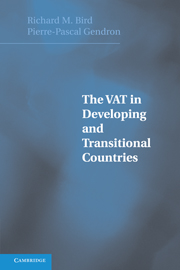Book contents
- Frontmatter
- Contents
- List of Tables
- Preface
- 1 Why This Book?
- 2 The Rise of VAT
- 3 Is VAT Always the Answer?
- 4 Trade and Revenue
- 5 Equity and the Informal Sector
- 6 What Should Be Taxed?
- 7 Key Issues in VAT Design
- 8 New Issues in VAT Design
- 9 Administering VAT
- 10 Dealing with Difficulties
- 11 The Political Economy of VAT
- 12 Where Do We Go from Here?
- Annex
- References
- Index
7 - Key Issues in VAT Design
Published online by Cambridge University Press: 16 November 2009
- Frontmatter
- Contents
- List of Tables
- Preface
- 1 Why This Book?
- 2 The Rise of VAT
- 3 Is VAT Always the Answer?
- 4 Trade and Revenue
- 5 Equity and the Informal Sector
- 6 What Should Be Taxed?
- 7 Key Issues in VAT Design
- 8 New Issues in VAT Design
- 9 Administering VAT
- 10 Dealing with Difficulties
- 11 The Political Economy of VAT
- 12 Where Do We Go from Here?
- Annex
- References
- Index
Summary
Once the base of a VAT is determined, several key design issues such as the level and structure of rates must be resolved. Many lessons for VAT design suggested by experience in developed countries are relevant everywhere, but some need to be reconsidered in developing and transitional countries, in which tax reality is even more dominated by administrative capacity and political necessity. As Laffont (2004) remarked in surveying another important policy issue (public utility regulation), not only do we have surprisingly little solid empirical knowledge about the critical factors determining what policy design is best for any particular country, but even the relevant economic theory remains rather sketchy. Moreover, outside experts often know even less about the relevant political economy context. In this chapter we consider some of the important aspects of VAT design that require close analysis of the country in question: rates, thresholds, exemptions, zero-rating, and excises.
RATES
Expert advice on VAT rates is simple: there should be only one rate. (Actually, this means that there should be two rates, since a zero rate should be imposed on exports.) The uniformity of this ‘uniform’ rate advice rests on the assumption that the administrative and compliance costs of rate differentiation outweigh efficiency and equity arguments that might be made for such differentiation. Administratively, more rates seem clearly to be associated with higher administrative and compliance costs and hence reduced VAT ‘efficiency’ in the terms discussed in Chapter 4 (Cnossen 2004).
Information
- Type
- Chapter
- Information
- The VAT in Developing and Transitional Countries , pp. 108 - 137Publisher: Cambridge University PressPrint publication year: 2007
Accessibility standard: Unknown
Why this information is here
This section outlines the accessibility features of this content - including support for screen readers, full keyboard navigation and high-contrast display options. This may not be relevant for you.Accessibility Information
- 1
- Cited by
